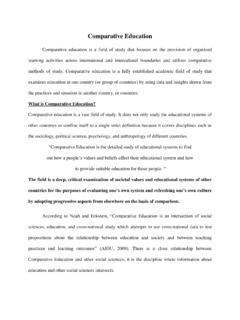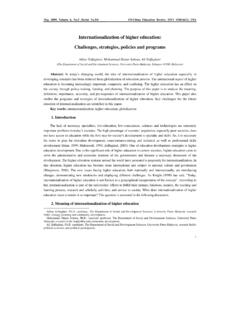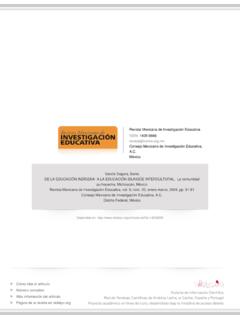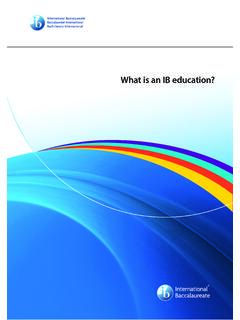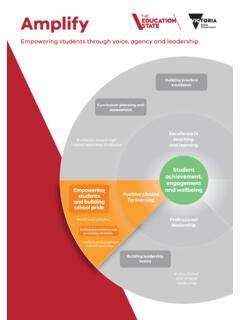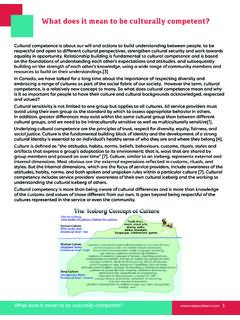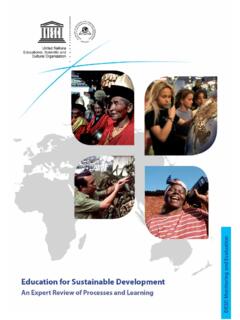Transcription of Intercultural communicative competence: creating awareness ...
1 10513 Intercultural communicative competence: creating awareness and promoting skills in the language classroomSandra L pez-Rocha1 AbstractIntercultural communicative Competence (ICC) needs to be incorporated in the language curriculum if educators hope to help students develop an appreciation for the language and culture studied, an awareness of their own culture, and the development of skills that will allow them to be competent, adaptable, communicators. The key question addressed in this paper focuses on the importance placed on the incorporation of those skills, now recognised as crucial when learning a language: are we as teachers creating the conditions for the development of ICC, or are we simply hoping students will become interculturally competent on their own? It is, thus, necessary to understand what is meant by ICC, why must we consider fully integrating it in the language curriculum, and address the challenges associated with its : Intercultural communicative competence, cultural awareness , language IntroductionIn the last decades, Intercultural Competence was reintroduced as Intercultural communicative Competence (ICC) as the result of its impact on foreign language teaching (L pez-Rocha & Ar valo-Guerrero, 2014).
2 The distinction between the two needs to be understood when we make decisions on the cultural 1. University of Bristol, United Kingdom; to cite this chapter: L pez-Rocha, S. (2016). Intercultural communicative competence: creating awareness and promoting skills in the language classroom. In C. Goria, O. Speicher, & S. Stollhans (Eds), Innovative language teaching and learning at university: enhancing participation and collaboration (pp. 105-111). Dublin: 13 106content in the curriculum. With regards to ICC, one of the key questions for language tutors is whether or not we are preparing students for this challenge: are we providing general information hoping students will develop the skills they need to communicate more efficiently and understand cultural tendencies? Or, conversely, are we creating the conditions for students to develop skills preparing them for the Intercultural challenge? This paper aims, first, to address key issues in the language classroom with regards to fostering the development of ICC among foreign language students, and second, to provide practical ideas for tutors to promote ICC in a more integral way.
3 The key idea is that students need to be further challenged and guided in order to develop critical communicative Why ICC?As Hennebry (2014) observes, [i]t has been argued that culture is the marginalized sister of language (p. 135). What is interesting about this quote is that this idea has been echoed by students, suggesting [i]t would be nice if we are studying the language to know a bit more about the country and what people are like there (Jones, 2000, p. 158). The question that remains, which is indeed our concern, is how can we help students learn about culture and develop Intercultural awareness and ICC? Although it is true that we as tutors strive to provide a cultural foundation for students, this often presents important shortcomings. One of the most significant problems is that we, perhaps inadvertently, may indeed reinforce stereotypes because, instead of fostering ICC, we often focus exclusively on the language as communication, while the context in which that communication occurs, and which gives meaning to the messages, is often relegated to second place.
4 It is, thus, necessary to understand what we mean by the culture that needs to be promoted in class. One way to visualise it is by studying the Iceberg Theory advanced by Edward T. Hall (1976), contrasting the surface/conscious (food, language, festivals) and deep/unconscious (beliefs, values, perceptions) elements of culture. These elements influence our actions, behaviours and the way we interact with each other. In addition, oftentimes these hidden elements of culture are the ones Sandra L pez-Rocha 107responsible for culture shock and misunderstandings, potentially leading to stereotyping and even is necessary to distinguish between Intercultural Competence and Intercultural communicative Competence. According to Byram (1997), the first refers to people s ability to interact in their own language with the people from another country and culture, while ICC takes into account language teaching and focuses on the ability to interact with people from another country and culture in a foreign language (p.)
5 71). In Byram s (1997) view, a person who has developed ICC is able to build relationships while speaking in the foreign language; communicates effectively, taking into consideration his own and the other person s viewpoint and needs; mediates interactions between people of different backgrounds, and strives to continue developing communicative Incorporating culture in our language classes in a different wayGlobalization and migratory movements have highlighted the need to integrate interculturality in the language curriculum. This is reflected in the Council of Europe s (2001) document addressing plurilingual education in Europe in order to promote teaching and learning of signatory states languages. This document included sections on the importance of promoting Intercultural communication and the understanding of cultural differences. Other arguments supporting a more engaging role of culture in the curriculum highlight the need to explore authentic representations of culture as opposed to superficial elements; the current demand to understand identity and appreciate similarities and differences (cf.
6 L pez-Rocha & Ar valo-Guerrero, 2014), our responsibility to prepare global citizens (cf. Sinicrope, Norris & Watanabe, 2007), and the result of studying other defining models, such as the US Standards for Foreign Language Learning (ACTFL, 2006) that define language goals in terms of communication, cultures, connections, comparisons, and communities, aimed at preparing students to develop linguistic and Intercultural 13 108 Curriculum design should take into consideration Deardorff s (2006) Process Model of Intercultural Competence, which emphasises the development of self- awareness , openness, and transformation (see also Furstenberg, 2010), and serves as a common denominator for various models and approaches to the development of ICC. In addition, what we should be expected to teach can be summarised in Byram s (1997; 2008) model of ICC involving five savoirs: knowledge, attitudes, education , skills to understand and order to help our students become more competent in terms of culture knowledge and interactions, we should explore ready-made activities or design new ones that support objectives consistent with the development of ICC skills.
7 With regards to their integration, we can start by observing how the CEFR incorporates culture as a component in language teaching, particularly as the classroom context is described as learner-centred, and welcomes interactivity, active participation, and cooperation among peers. Byram, Gribkova, and Starkey (2002) point out that based on the CEFR, foreign language teachers are required to promote curiosity and independent exploration and inquiry in order for students to be active participants while developing Intercultural is necessary to evaluate the materials or resources available prior to their use in our classes, as oftentimes the materials included in books may indeed be constraining or perpetuating stereotypes, instead of helping students understand diverging cultural practices. It is important for students to be further challenged and guided in order to develop critical communicative skills. Furthermore, as we strive to create the right conditions, Byram (1997) suggests that the focus should not be solely on preparing students to communicate without mistakes, but to communicate openly, forging relationships that will allow them to thrive in the foreign cultural context.
8 We need to help students develop Intercultural awareness and provide activities where the other s culture, values, and behaviours are considered (Byram, 1997). In order to allow students to learn about themselves and others we can use stereotypes, but only in order to deconstruct them and address misperceptions. Students will also need to first understand, and then explain, the sources of Intercultural conflict and how to deal with them, while Sandra L pez-Rocha 109avoiding misunderstandings. Ultimately, we want to help students become interculturally competent ChallengesIn addition to finding the right balance between language and culture, the types of activities we use, the level of motivation and engagement of students as well as teachers, and our own preparedness for the promotion of ICC skills, one of the greater challenges we face is assessment. It is not easy to assess the level of Intercultural competence that each student has achieved, since they start with different perceptions and go through the process at different rates.
9 It is then necessary to consider the classroom experience as a process (Byram, 1997; Deardorff, 2006), where each experience becomes the ultimate goal for each of the students. Furthermore, some researchers propose open assessment, where the student and the teacher discuss and record the progress (Scarino, 2010), while others support the idea of a portfolio, as it facilitates the interpretation of meaning, critical reflection, self-evaluation, feedback, and the opportunity to become aware of transformations (Schulz, 2007). Other challenges point at the exploration of which culture? It is not only a matter of national cultures, but also regional differences and the way the teacher s own experience and knowledge will impact the ConclusionThe need for cultural awareness continues to gather momentum, creating an urgent need to promote Intercultural and linguistic competence among learners. It is our responsibility, as language teachers, to create the conditions for students to develop ICC to prepare them to interact in Intercultural and diverse environments.
10 In other words, language teaching should incorporate skills and strategies for developing cultural awareness leading to ICC for global citizenship. Culture teaching approaches should move from the descriptive to the interactionists, fostering interactions and discussion leading to self- awareness , openness, and Chapter 13 110transformation. It is necessary to be aware not only of the need to develop ICC skills, but also the challenges involved in the process. Finally, developing Intercultural awareness must be combined with language learning, where we use our own experience to enhance the students exploration of culture: Their own and that of the target (2006). Standards for foreign language learning in the 21st century. Yonkers, NY: National Standards in Foreign Language education , M. (1997). Teaching and assessing Intercultural communicative competence. Clevendon: Multilingual , M. (2008). From foreign language education to education for Intercultural citizenship: essays and reflections.










